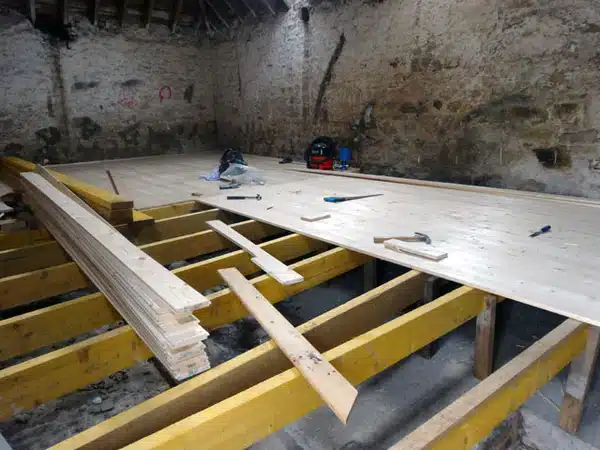SPECIFICATION GENERATOR
Find out which low impact materials are right for your building project.
How do I insulate a suspended ground floor?
Find out more about how we approach this building scenario.

This is a common problem in retrofit projects as it can be tricky to get anything underneath the floor structure to hold up your insulation. Installing insulation without any support is risky as over time and with the vibration that walking over the floor causes, the insulation can slowly fall out.
How to insulate suspended floor structures
From our experience the simplest way to insulate suspended floor structures is to suspend a flexible type of insulation between the joists, such as our flexible wood fibre insulation. This is achieved by draping a basic, cost effective (cheap!) breathable underlay material to the required depth between the joists and then simply pressing the insulation in to the ‘cradle’ that this creates. This membrane can be stapled to the top and bottom edges of the joists if required.
Rigid insulation boards, such as PIR or EPS, are very difficult to cut and install accurately in this scenario and are therefore unlikely to be effective.
To calculate how much breather membrane you’ll need, you’ll need to know the dimensions of your floor, the depth of your joists and the number of them across the floor. Take the measurement of the room that runs perpendicular to the direction of the joists and then add the number of joists multiplied by twice their depth. For example, if you have a 5m wide room with 13 joists of 150mm in depth you’ll need to add 13 x 300mm or 3.9m to the width, making 8.9m. You can then multiply this total by the other dimension of the room to calculate the area of membrane required.
In addition to installing this breather membrane and insulation, it is very important to use a vapour control layer. If you want to read about why you need a vapour control layer (VCL) then please read here. The joints in the VCL need to be well taped and it should also be well taped around the perimeter to the walls. This will ensure that the moisture content of the floor structure is correct and also ensures your floor is air tight.
Once the VCL is installed you can fix your floor boards down again. This should be done carefully to avoid any unnecessary punctures to the VCL. Alternatively you can apply a strip of Butyl tape to the top of each joist which will seal up around nail/screw holes should you need to take up the floor boards again.
If you’d like to know more about floor insulation and how to install it please contact us at chris@backtoearth.co.uk or alternatively give us a call on 01392 861763.

Good evening
Do you have a list of accredited or recommended installers of your products in the West Midlands please?
Kind regards
Samuel